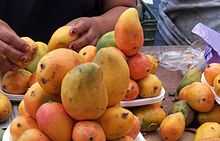Mangifera indica
| Mango | |
|---|---|
 | |
| Scientific classification | |
| Kingdom: | Plantae |
| (unranked): | Angiosperms |
| (unranked): | Eudicots |
| (unranked): | Rosids |
| Order: | Sapindales |
| Family: | Anacardiaceae |
| Genus: | Mangifera |
| Species: | M. indica |
| Binomial name | |
| Mangifera indica L. | |
Mangifera indica is a species of mango in the Anacardiaceae family. It is found in the wild in India and cultivated varieties have been introduced to other warm regions of the world. It is the largest fruit-tree in the world, capable of a height of one-hundred feet and an average circumference of twelve to fourteen feet, sometimes reaching twenty.[1]
The species appears to have been domesticated about 4,000 years ago.[citation needed] The species was brought to East Asia around 400-500 BCE from India; next, in the 15th century to the Philippines; and then, in the 16th century to Africa and Brazil by the Portuguese.[2] The species was described for science by Linnaeus in 1753.[3]

Mango is the national fruit of India, Pakistan and the Philippines. It finds mention in the songs of 4th century CE Sanskrit poet Kalidasa. Prior to that, it is believed to have been tasted by Alexander (3rd century BCE) and Chinese pilgrim Hieun Tsang (7th century CE). Later in 16th century Mughal Emperor, Akbar planted 100,000 mango trees in Darbhanga, Bihar at a place now known as Lakhi Bagh.[4]
Chemical constituents

Mangiferin (a pharmacologically active flavonoid, a natural xanthone C-glycoside) is extracted from Mango at high concentrations from the young leaves (172 g/kg), bark (107 g/kg), and from old leaves (94 g/kg).[5] Allergenic urushiols are present in the fruit peel and can trigger contact dermatitis in sensitised individuals. This reaction is more likely to occur in people who have been exposed to other plants from the Anacardiaceae family, such as poison oak and poison ivy, which are widespread in the United States.[6]
Traditional medicine
In ayurveda, it is used in a Rasayana formula (q.v.), clearing digestion and acidity due to pitta (heat), sometimes with other mild sours and shatavari (Asparagus racemosus) and guduchi (Tinospora cordifolia). In this oriental system of traditional medicines, varied medicinal properties are attributed to different parts of the mango tree, both as food and medicine. It is anti-diuretic, anti-diarrheal, anti-emetic and cardiac herb.[7]
References
- ↑ (1846). The Missionary guide-book, p.180. Seeley, Burnside, and Seeley.
- ↑ Gepts, P. (n.d.). "PLB143: Crop of the Day: Mango, Mangifera indica". The evolution of crop plants. Dept. of Plant Sciences, Sect. of Crop & Ecosystem Sciences, University of California, Davis. Retrieved October 8, 2009.
- ↑ GRIN (May 5, 1997). "Mangifera indica information from ARS/GRIN". Taxonomy for Plants. National Germplasm Resources Laboratory, Beltsville, Maryland: USDA, ARS, National Genetic Resources Program. Retrieved October 8, 2009.
- ↑ "National Fruit". Govt. of India Official website.
- ↑ Barreto J.C., Trevisan M.T.S., Hull W.E., Erben G., De Brito E.S., Pfundstein B., Würtele G., Spiegelhalder B., Owen R.W. (2008). "Characterization and quantitation of polyphenolic compounds in bark, kernel, leaves, and peel of mango (Mangifera indica L.)". Journal of Agricultural and Food Chemistry 56 (14): 5599–5610. doi:10.1021/jf800738r. PMID 18558692.
- ↑ Urushiol CASRN: 53237-59-5 TOXNET (Toxicology Data Network) NLM (NIH). Retrieved 22 January 2014.
- ↑ National R&D Facility For Rasayana
Further reading
- Litz, Richard E. (ed. 2009). The Mango: Botany, Production and Uses (2nd edition). CABI. ISBN 978-1-84593-489-7
External links
| Wikimedia Commons has media related to Mangifera indica. |
| Wikispecies has information related to: Mangifera indica |
| Wikibooks Cookbook has a recipe/module on |
- Crop of the Day: Mango, Mangifera indica has a list of helpful resources about this species.